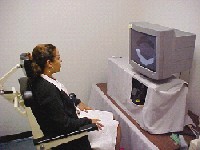A faster, more objective glaucoma test, developed within the optometric community, is on its way. Researchers at the State University of New York State College of Optometry (SUNY) are in the process of perfecting a visual field test that takes about two minutes and relies on objective measurements of pupillary response, not a patients subjective reaction.
Harry Wyatt, Ph.D., a professor of anatomy and physiology of the visual system at SUNY, reasoned that the pupils light reflex could provide clues to visual field damage. The instrument he and his colleagues developed, with the aid of a grant from the National Eye Institute, challenges the pupillary response with three alternating pairs of stimuli above and below the horizontal meridian. The test takes advantage of the symmetry between the upper and lower retina. When the retinal area that is under stimulation reacts to the light, the pupil responds, and the response is measured.
 |
| New glaucoma test uses pupil response. |
The pupil is very sensitive to the balance in the effectiveness of the pair of stimuli, Dr. Wyatt says. If theres an imbalance thats big enough, that means that one of these two territories is showing an afferent defect when compared to the other one.
The test also measures the degree of response, which indicates the level of glaucoma damage.
To perform the test, the patient sits in front of a screen that flashes stimuli in shapes that are characteristic of glaucoma. For instance, one stimulus corresponds roughly to Bjerrums arcuate scotoma. Using large characteristic territories of the visual field speeds up the testing time, Dr. Wyatt says.
Also, one of the things that distinguishes this from regular perimetry is that the patient doesnt have to say anything or push any buttons, he says. In an exit poll of patients who used this pupillometric test, 38 out of 41 (92%) said it was easier or somewhat easier than a conventional visual field test.
Analysis of patient data shows low variability both within the testing session and between testing sessions. While the test is promising as a screening tool, Dr. Wyatt says, it could be more useful in following disease progression. He hopes this prototype will lead to a commercial instrument in a few years.

